Analysis of the UK Taxation Environment: A Comprehensive Report
VerifiedAdded on 2021/04/21
|29
|4640
|36
Report
AI Summary
This report provides a comprehensive overview of the UK taxation environment. It begins with an introduction to the concept of taxation, differentiating between direct and indirect taxes, and explaining the structure of the UK taxation system. The report delves into the history of UK taxation, tracing its evolution and key milestones. It then explores the roles and responsibilities of tax practitioners, detailing their functions in ensuring compliance and providing advisory services. The report also examines individual and business tax obligations, including compliance requirements and the consequences of non-compliance. Finally, the report includes a case study analyzing the tax calculations for a self-employed individual, providing practical application of the concepts discussed. The analysis includes considerations for income, deductions, and taxable profit.
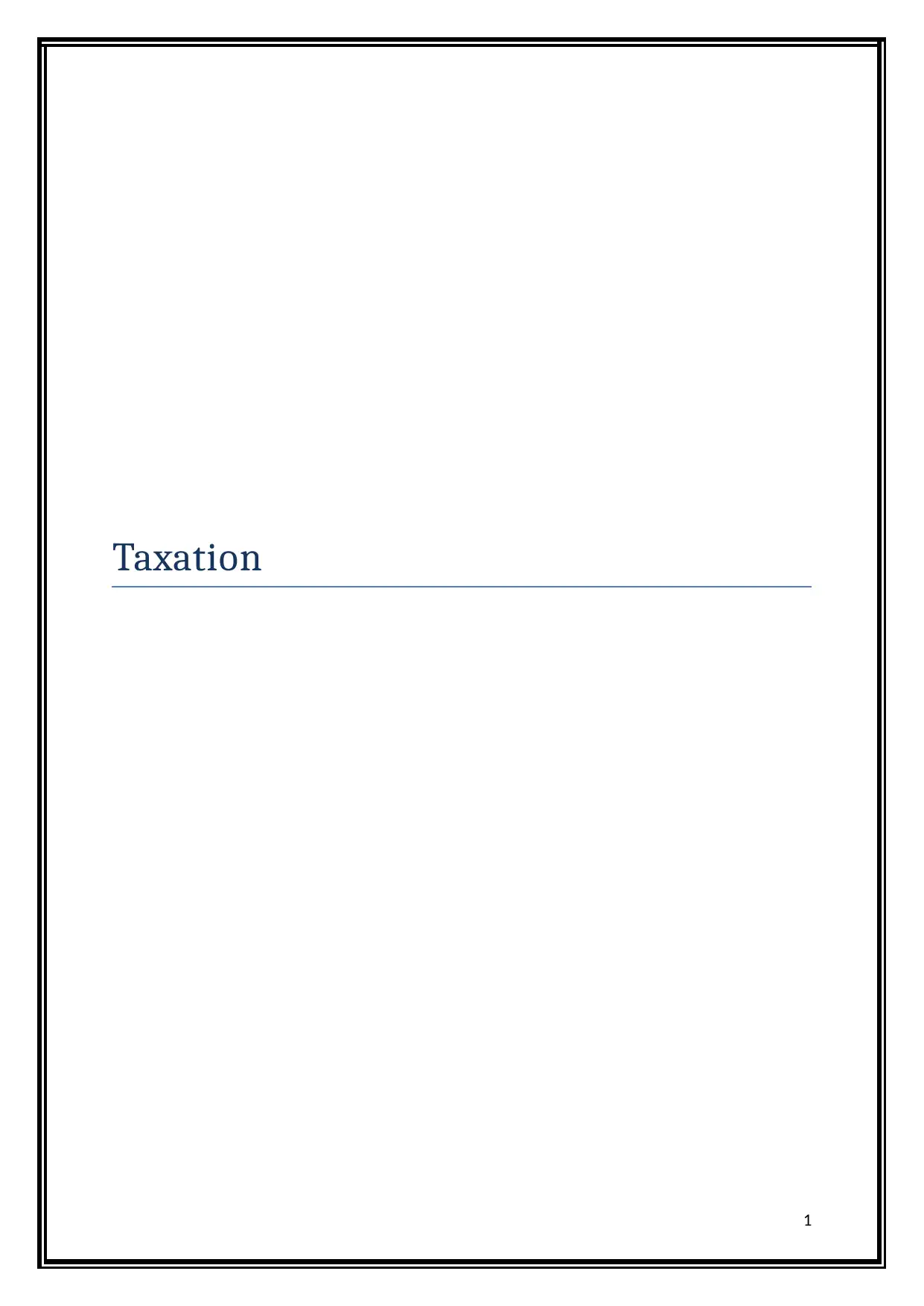
Taxation
1
1
Paraphrase This Document
Need a fresh take? Get an instant paraphrase of this document with our AI Paraphraser
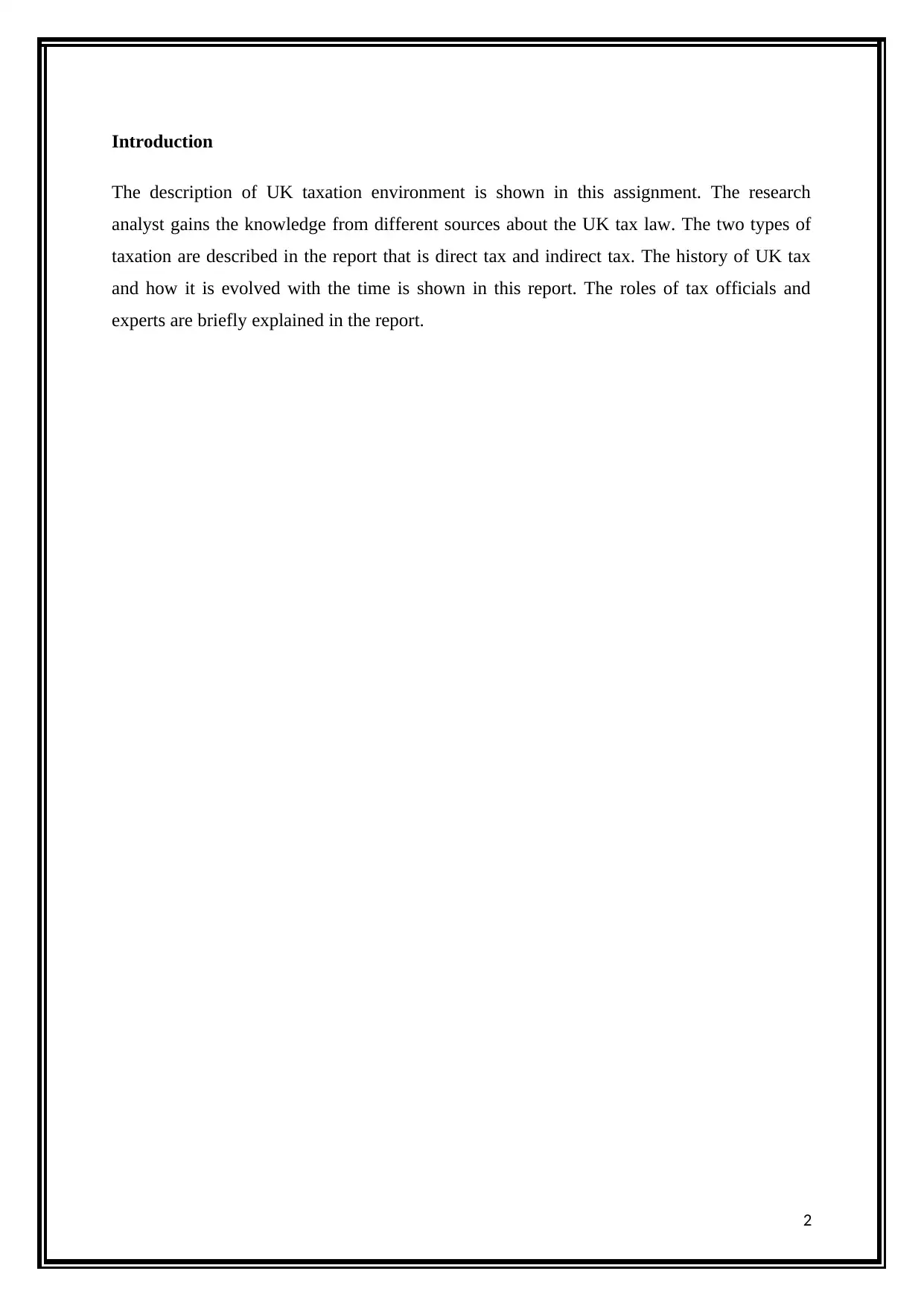
Introduction
The description of UK taxation environment is shown in this assignment. The research
analyst gains the knowledge from different sources about the UK tax law. The two types of
taxation are described in the report that is direct tax and indirect tax. The history of UK tax
and how it is evolved with the time is shown in this report. The roles of tax officials and
experts are briefly explained in the report.
2
The description of UK taxation environment is shown in this assignment. The research
analyst gains the knowledge from different sources about the UK tax law. The two types of
taxation are described in the report that is direct tax and indirect tax. The history of UK tax
and how it is evolved with the time is shown in this report. The roles of tax officials and
experts are briefly explained in the report.
2

Task 1
AC1.1
Description of UK taxation and its environment
The tax is compulsory contribution made by the peoples of a country to the government. The
government charges tax from the citizens in the form of money. The tax is taken by the
government to use the money for the development of the country. The non-payment of tax
leads towards to the offence towards the government. The punishment is given by the
government as per it is described in the taxation law. The assessment of taxation in UK has
gone through at least three unique levels. The structure of UK taxation environment is as
follows:
The tax of any country is mainly divided into two parts. These two parts are known as direct
tax and the indirect tax. The tax paid on the income is known as income tax and it forms a
major part of the direct tax. The tax paid on the wealth is known as wealth tax. It is also the
3
AC1.1
Description of UK taxation and its environment
The tax is compulsory contribution made by the peoples of a country to the government. The
government charges tax from the citizens in the form of money. The tax is taken by the
government to use the money for the development of the country. The non-payment of tax
leads towards to the offence towards the government. The punishment is given by the
government as per it is described in the taxation law. The assessment of taxation in UK has
gone through at least three unique levels. The structure of UK taxation environment is as
follows:
The tax of any country is mainly divided into two parts. These two parts are known as direct
tax and the indirect tax. The tax paid on the income is known as income tax and it forms a
major part of the direct tax. The tax paid on the wealth is known as wealth tax. It is also the
3
⊘ This is a preview!⊘
Do you want full access?
Subscribe today to unlock all pages.

Trusted by 1+ million students worldwide
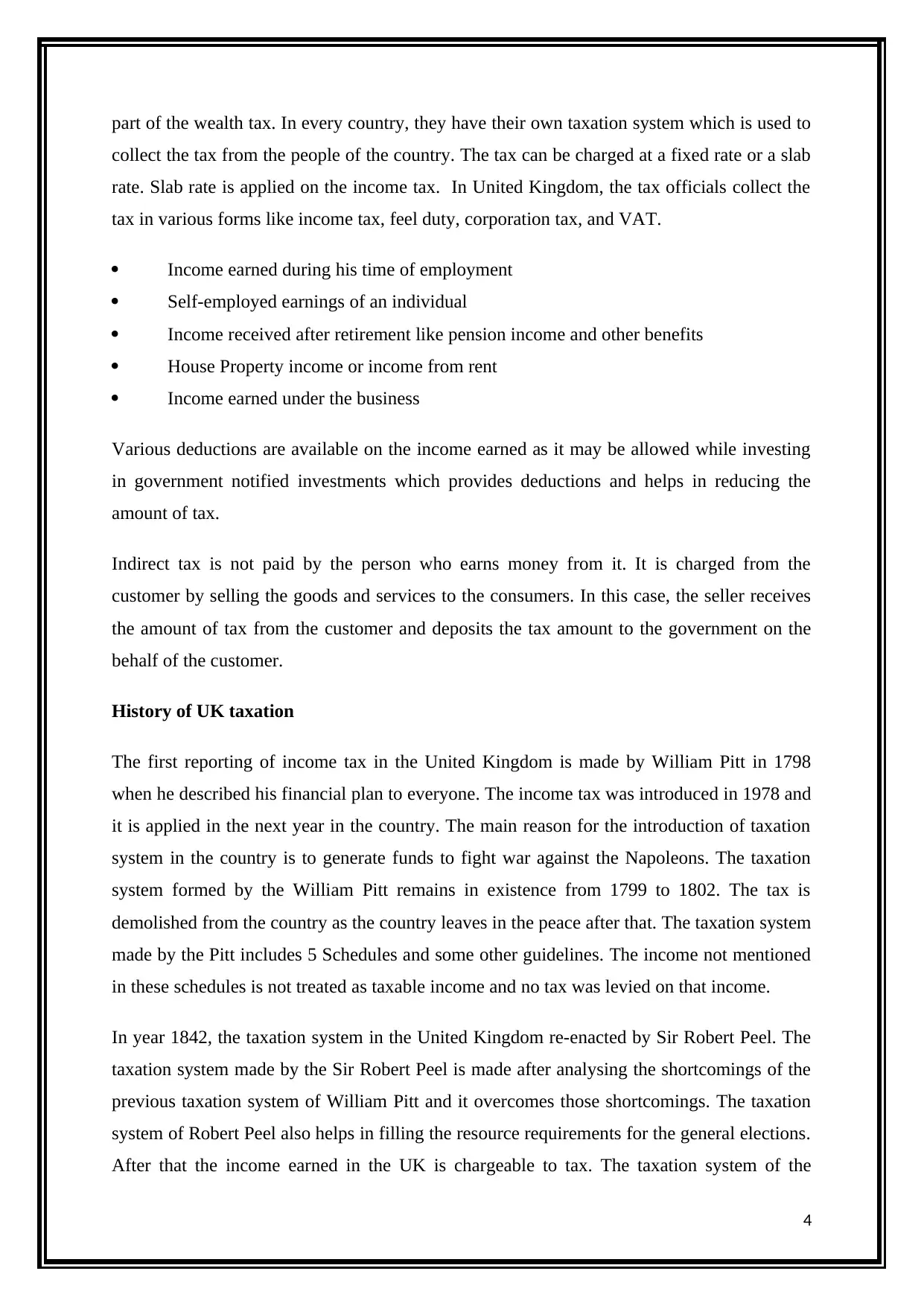
part of the wealth tax. In every country, they have their own taxation system which is used to
collect the tax from the people of the country. The tax can be charged at a fixed rate or a slab
rate. Slab rate is applied on the income tax. In United Kingdom, the tax officials collect the
tax in various forms like income tax, feel duty, corporation tax, and VAT.
Income earned during his time of employment
Self-employed earnings of an individual
Income received after retirement like pension income and other benefits
House Property income or income from rent
Income earned under the business
Various deductions are available on the income earned as it may be allowed while investing
in government notified investments which provides deductions and helps in reducing the
amount of tax.
Indirect tax is not paid by the person who earns money from it. It is charged from the
customer by selling the goods and services to the consumers. In this case, the seller receives
the amount of tax from the customer and deposits the tax amount to the government on the
behalf of the customer.
History of UK taxation
The first reporting of income tax in the United Kingdom is made by William Pitt in 1798
when he described his financial plan to everyone. The income tax was introduced in 1978 and
it is applied in the next year in the country. The main reason for the introduction of taxation
system in the country is to generate funds to fight war against the Napoleons. The taxation
system formed by the William Pitt remains in existence from 1799 to 1802. The tax is
demolished from the country as the country leaves in the peace after that. The taxation system
made by the Pitt includes 5 Schedules and some other guidelines. The income not mentioned
in these schedules is not treated as taxable income and no tax was levied on that income.
In year 1842, the taxation system in the United Kingdom re-enacted by Sir Robert Peel. The
taxation system made by the Sir Robert Peel is made after analysing the shortcomings of the
previous taxation system of William Pitt and it overcomes those shortcomings. The taxation
system of Robert Peel also helps in filling the resource requirements for the general elections.
After that the income earned in the UK is chargeable to tax. The taxation system of the
4
collect the tax from the people of the country. The tax can be charged at a fixed rate or a slab
rate. Slab rate is applied on the income tax. In United Kingdom, the tax officials collect the
tax in various forms like income tax, feel duty, corporation tax, and VAT.
Income earned during his time of employment
Self-employed earnings of an individual
Income received after retirement like pension income and other benefits
House Property income or income from rent
Income earned under the business
Various deductions are available on the income earned as it may be allowed while investing
in government notified investments which provides deductions and helps in reducing the
amount of tax.
Indirect tax is not paid by the person who earns money from it. It is charged from the
customer by selling the goods and services to the consumers. In this case, the seller receives
the amount of tax from the customer and deposits the tax amount to the government on the
behalf of the customer.
History of UK taxation
The first reporting of income tax in the United Kingdom is made by William Pitt in 1798
when he described his financial plan to everyone. The income tax was introduced in 1978 and
it is applied in the next year in the country. The main reason for the introduction of taxation
system in the country is to generate funds to fight war against the Napoleons. The taxation
system formed by the William Pitt remains in existence from 1799 to 1802. The tax is
demolished from the country as the country leaves in the peace after that. The taxation system
made by the Pitt includes 5 Schedules and some other guidelines. The income not mentioned
in these schedules is not treated as taxable income and no tax was levied on that income.
In year 1842, the taxation system in the United Kingdom re-enacted by Sir Robert Peel. The
taxation system made by the Sir Robert Peel is made after analysing the shortcomings of the
previous taxation system of William Pitt and it overcomes those shortcomings. The taxation
system of Robert Peel also helps in filling the resource requirements for the general elections.
After that the income earned in the UK is chargeable to tax. The taxation system of the
4
Paraphrase This Document
Need a fresh take? Get an instant paraphrase of this document with our AI Paraphraser
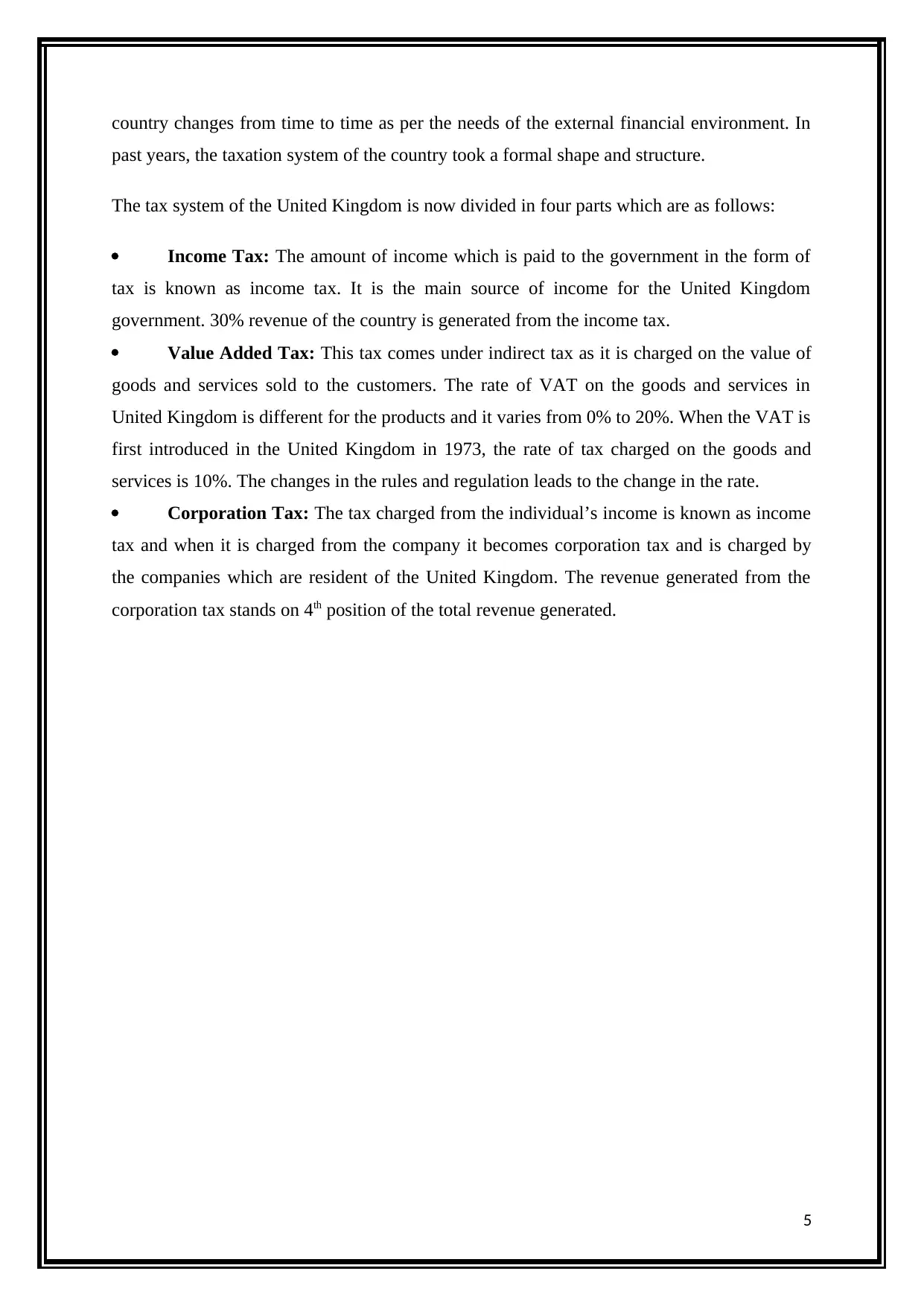
country changes from time to time as per the needs of the external financial environment. In
past years, the taxation system of the country took a formal shape and structure.
The tax system of the United Kingdom is now divided in four parts which are as follows:
Income Tax: The amount of income which is paid to the government in the form of
tax is known as income tax. It is the main source of income for the United Kingdom
government. 30% revenue of the country is generated from the income tax.
Value Added Tax: This tax comes under indirect tax as it is charged on the value of
goods and services sold to the customers. The rate of VAT on the goods and services in
United Kingdom is different for the products and it varies from 0% to 20%. When the VAT is
first introduced in the United Kingdom in 1973, the rate of tax charged on the goods and
services is 10%. The changes in the rules and regulation leads to the change in the rate.
Corporation Tax: The tax charged from the individual’s income is known as income
tax and when it is charged from the company it becomes corporation tax and is charged by
the companies which are resident of the United Kingdom. The revenue generated from the
corporation tax stands on 4th position of the total revenue generated.
5
past years, the taxation system of the country took a formal shape and structure.
The tax system of the United Kingdom is now divided in four parts which are as follows:
Income Tax: The amount of income which is paid to the government in the form of
tax is known as income tax. It is the main source of income for the United Kingdom
government. 30% revenue of the country is generated from the income tax.
Value Added Tax: This tax comes under indirect tax as it is charged on the value of
goods and services sold to the customers. The rate of VAT on the goods and services in
United Kingdom is different for the products and it varies from 0% to 20%. When the VAT is
first introduced in the United Kingdom in 1973, the rate of tax charged on the goods and
services is 10%. The changes in the rules and regulation leads to the change in the rate.
Corporation Tax: The tax charged from the individual’s income is known as income
tax and when it is charged from the company it becomes corporation tax and is charged by
the companies which are resident of the United Kingdom. The revenue generated from the
corporation tax stands on 4th position of the total revenue generated.
5
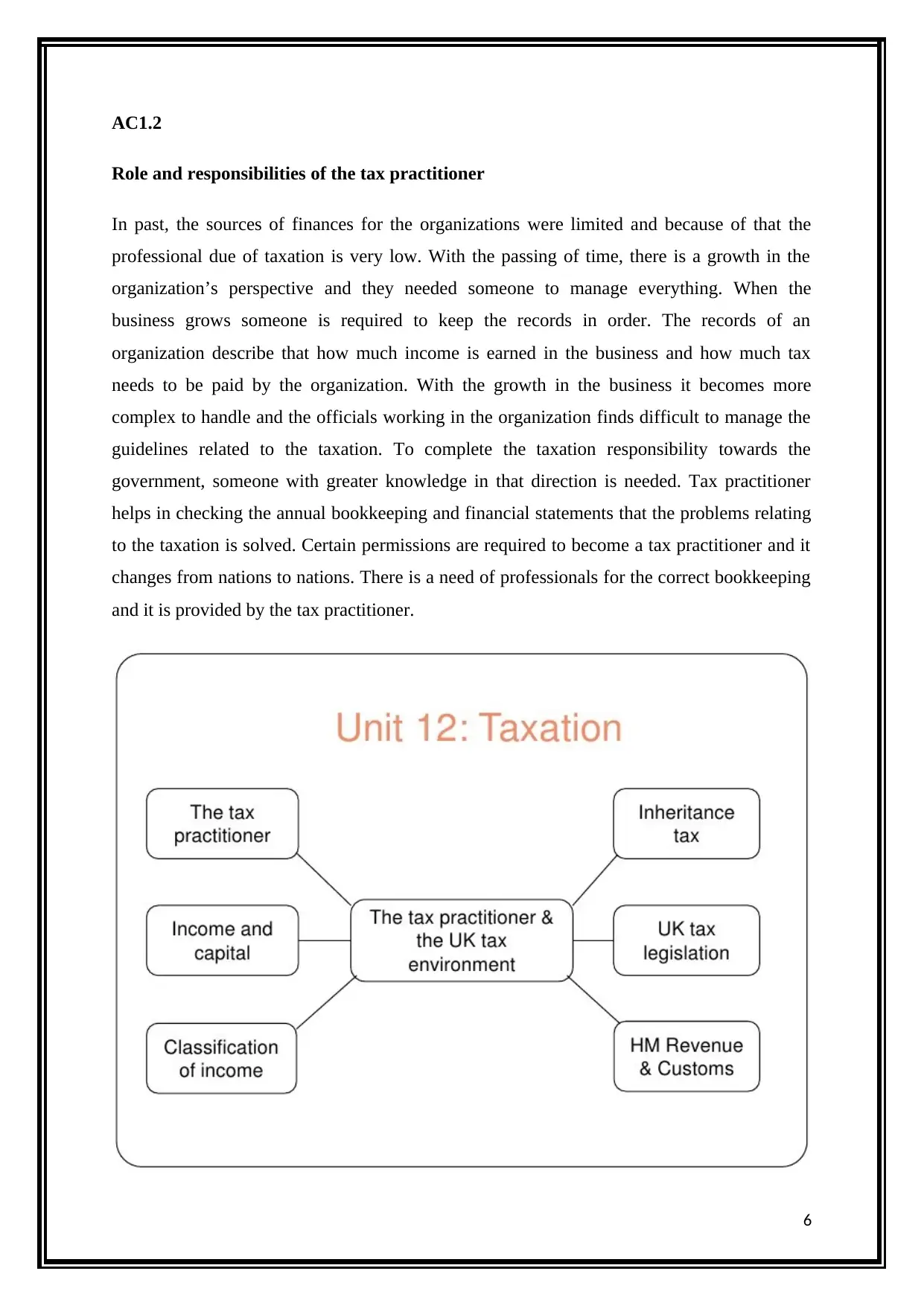
AC1.2
Role and responsibilities of the tax practitioner
In past, the sources of finances for the organizations were limited and because of that the
professional due of taxation is very low. With the passing of time, there is a growth in the
organization’s perspective and they needed someone to manage everything. When the
business grows someone is required to keep the records in order. The records of an
organization describe that how much income is earned in the business and how much tax
needs to be paid by the organization. With the growth in the business it becomes more
complex to handle and the officials working in the organization finds difficult to manage the
guidelines related to the taxation. To complete the taxation responsibility towards the
government, someone with greater knowledge in that direction is needed. Tax practitioner
helps in checking the annual bookkeeping and financial statements that the problems relating
to the taxation is solved. Certain permissions are required to become a tax practitioner and it
changes from nations to nations. There is a need of professionals for the correct bookkeeping
and it is provided by the tax practitioner.
6
Role and responsibilities of the tax practitioner
In past, the sources of finances for the organizations were limited and because of that the
professional due of taxation is very low. With the passing of time, there is a growth in the
organization’s perspective and they needed someone to manage everything. When the
business grows someone is required to keep the records in order. The records of an
organization describe that how much income is earned in the business and how much tax
needs to be paid by the organization. With the growth in the business it becomes more
complex to handle and the officials working in the organization finds difficult to manage the
guidelines related to the taxation. To complete the taxation responsibility towards the
government, someone with greater knowledge in that direction is needed. Tax practitioner
helps in checking the annual bookkeeping and financial statements that the problems relating
to the taxation is solved. Certain permissions are required to become a tax practitioner and it
changes from nations to nations. There is a need of professionals for the correct bookkeeping
and it is provided by the tax practitioner.
6
⊘ This is a preview!⊘
Do you want full access?
Subscribe today to unlock all pages.

Trusted by 1+ million students worldwide
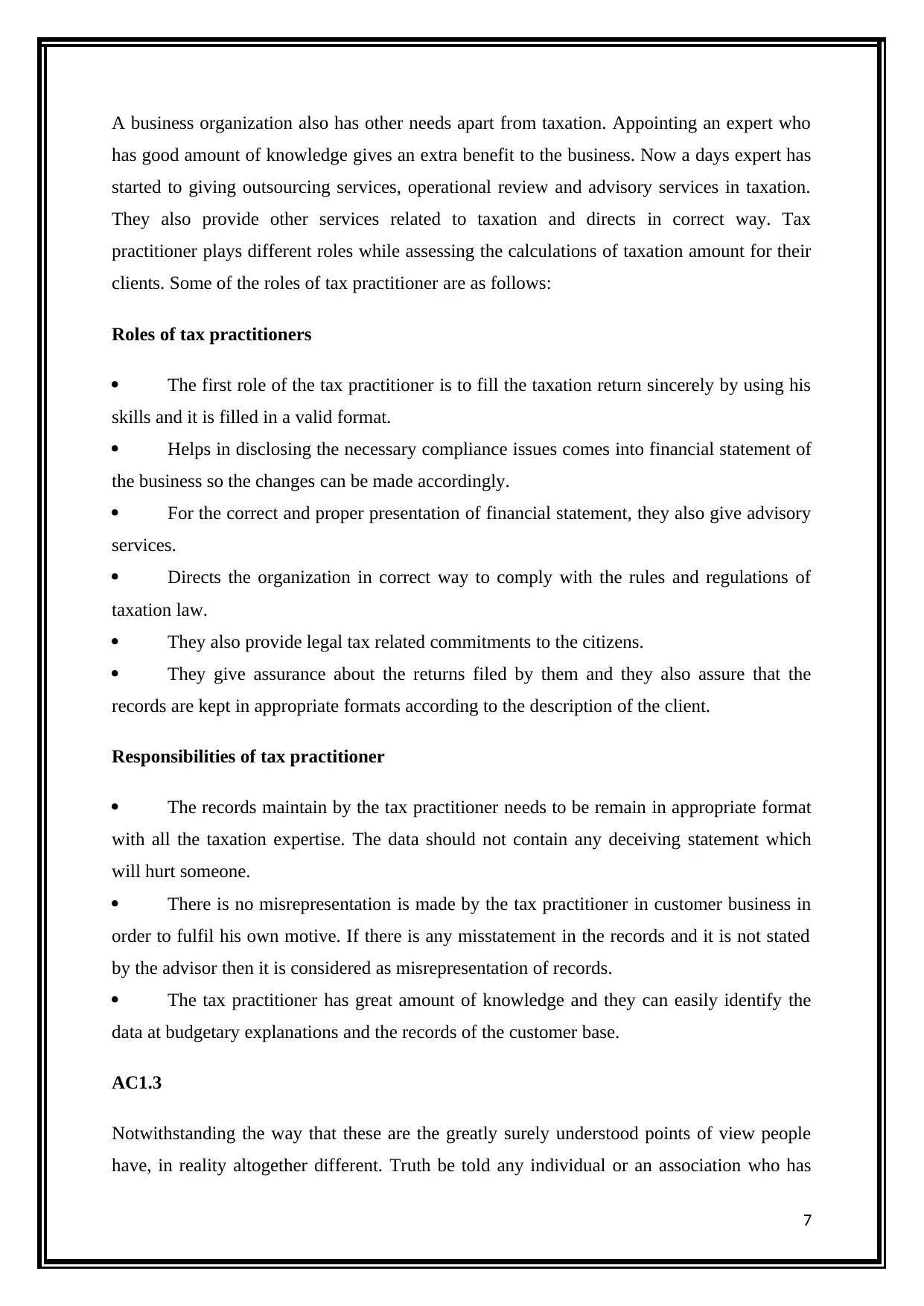
A business organization also has other needs apart from taxation. Appointing an expert who
has good amount of knowledge gives an extra benefit to the business. Now a days expert has
started to giving outsourcing services, operational review and advisory services in taxation.
They also provide other services related to taxation and directs in correct way. Tax
practitioner plays different roles while assessing the calculations of taxation amount for their
clients. Some of the roles of tax practitioner are as follows:
Roles of tax practitioners
The first role of the tax practitioner is to fill the taxation return sincerely by using his
skills and it is filled in a valid format.
Helps in disclosing the necessary compliance issues comes into financial statement of
the business so the changes can be made accordingly.
For the correct and proper presentation of financial statement, they also give advisory
services.
Directs the organization in correct way to comply with the rules and regulations of
taxation law.
They also provide legal tax related commitments to the citizens.
They give assurance about the returns filed by them and they also assure that the
records are kept in appropriate formats according to the description of the client.
Responsibilities of tax practitioner
The records maintain by the tax practitioner needs to be remain in appropriate format
with all the taxation expertise. The data should not contain any deceiving statement which
will hurt someone.
There is no misrepresentation is made by the tax practitioner in customer business in
order to fulfil his own motive. If there is any misstatement in the records and it is not stated
by the advisor then it is considered as misrepresentation of records.
The tax practitioner has great amount of knowledge and they can easily identify the
data at budgetary explanations and the records of the customer base.
AC1.3
Notwithstanding the way that these are the greatly surely understood points of view people
have, in reality altogether different. Truth be told any individual or an association who has
7
has good amount of knowledge gives an extra benefit to the business. Now a days expert has
started to giving outsourcing services, operational review and advisory services in taxation.
They also provide other services related to taxation and directs in correct way. Tax
practitioner plays different roles while assessing the calculations of taxation amount for their
clients. Some of the roles of tax practitioner are as follows:
Roles of tax practitioners
The first role of the tax practitioner is to fill the taxation return sincerely by using his
skills and it is filled in a valid format.
Helps in disclosing the necessary compliance issues comes into financial statement of
the business so the changes can be made accordingly.
For the correct and proper presentation of financial statement, they also give advisory
services.
Directs the organization in correct way to comply with the rules and regulations of
taxation law.
They also provide legal tax related commitments to the citizens.
They give assurance about the returns filed by them and they also assure that the
records are kept in appropriate formats according to the description of the client.
Responsibilities of tax practitioner
The records maintain by the tax practitioner needs to be remain in appropriate format
with all the taxation expertise. The data should not contain any deceiving statement which
will hurt someone.
There is no misrepresentation is made by the tax practitioner in customer business in
order to fulfil his own motive. If there is any misstatement in the records and it is not stated
by the advisor then it is considered as misrepresentation of records.
The tax practitioner has great amount of knowledge and they can easily identify the
data at budgetary explanations and the records of the customer base.
AC1.3
Notwithstanding the way that these are the greatly surely understood points of view people
have, in reality altogether different. Truth be told any individual or an association who has
7
Paraphrase This Document
Need a fresh take? Get an instant paraphrase of this document with our AI Paraphraser
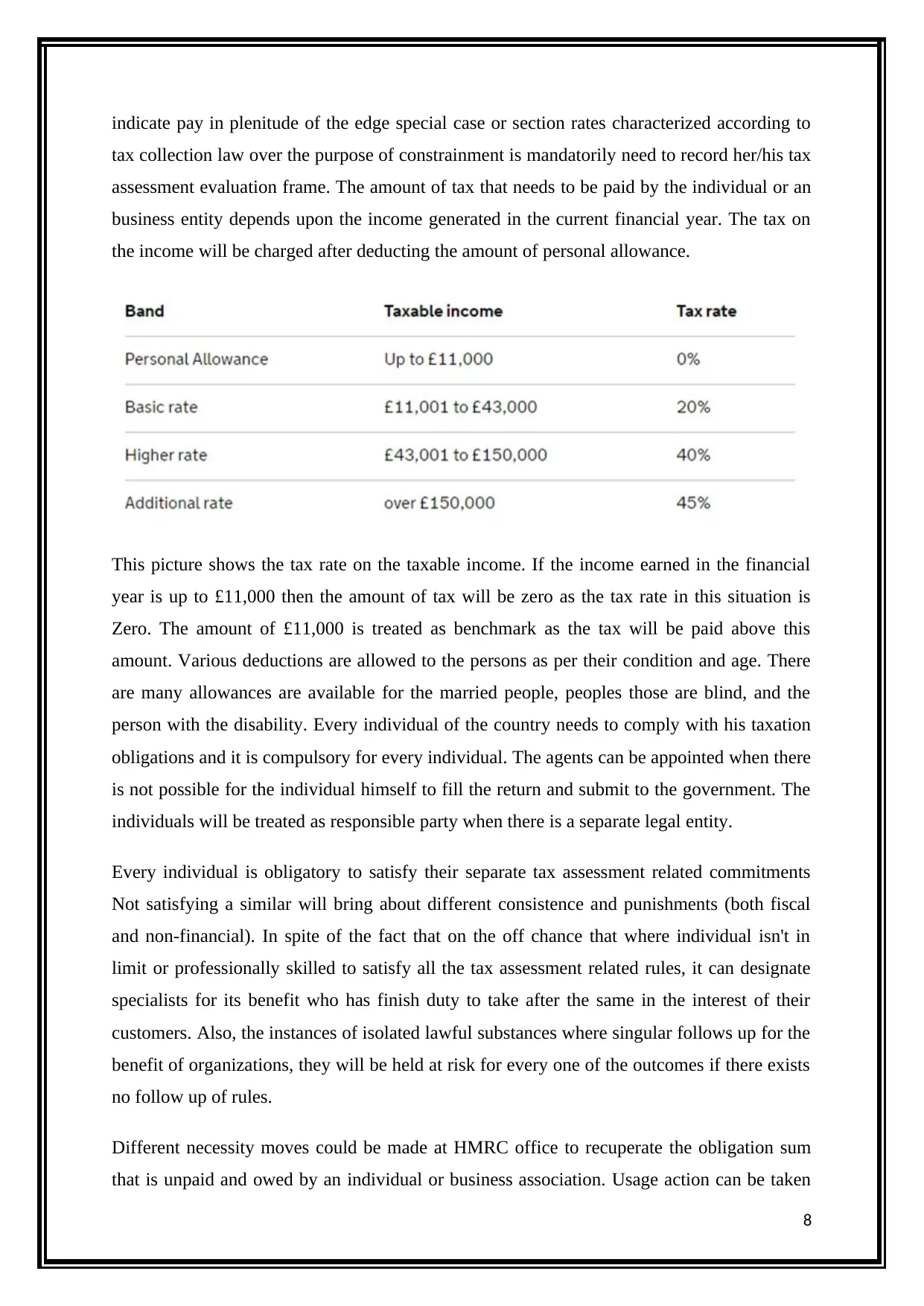
indicate pay in plenitude of the edge special case or section rates characterized according to
tax collection law over the purpose of constrainment is mandatorily need to record her/his tax
assessment evaluation frame. The amount of tax that needs to be paid by the individual or an
business entity depends upon the income generated in the current financial year. The tax on
the income will be charged after deducting the amount of personal allowance.
This picture shows the tax rate on the taxable income. If the income earned in the financial
year is up to £11,000 then the amount of tax will be zero as the tax rate in this situation is
Zero. The amount of £11,000 is treated as benchmark as the tax will be paid above this
amount. Various deductions are allowed to the persons as per their condition and age. There
are many allowances are available for the married people, peoples those are blind, and the
person with the disability. Every individual of the country needs to comply with his taxation
obligations and it is compulsory for every individual. The agents can be appointed when there
is not possible for the individual himself to fill the return and submit to the government. The
individuals will be treated as responsible party when there is a separate legal entity.
Every individual is obligatory to satisfy their separate tax assessment related commitments
Not satisfying a similar will bring about different consistence and punishments (both fiscal
and non-financial). In spite of the fact that on the off chance that where individual isn't in
limit or professionally skilled to satisfy all the tax assessment related rules, it can designate
specialists for its benefit who has finish duty to take after the same in the interest of their
customers. Also, the instances of isolated lawful substances where singular follows up for the
benefit of organizations, they will be held at risk for every one of the outcomes if there exists
no follow up of rules.
Different necessity moves could be made at HMRC office to recuperate the obligation sum
that is unpaid and owed by an individual or business association. Usage action can be taken
8
tax collection law over the purpose of constrainment is mandatorily need to record her/his tax
assessment evaluation frame. The amount of tax that needs to be paid by the individual or an
business entity depends upon the income generated in the current financial year. The tax on
the income will be charged after deducting the amount of personal allowance.
This picture shows the tax rate on the taxable income. If the income earned in the financial
year is up to £11,000 then the amount of tax will be zero as the tax rate in this situation is
Zero. The amount of £11,000 is treated as benchmark as the tax will be paid above this
amount. Various deductions are allowed to the persons as per their condition and age. There
are many allowances are available for the married people, peoples those are blind, and the
person with the disability. Every individual of the country needs to comply with his taxation
obligations and it is compulsory for every individual. The agents can be appointed when there
is not possible for the individual himself to fill the return and submit to the government. The
individuals will be treated as responsible party when there is a separate legal entity.
Every individual is obligatory to satisfy their separate tax assessment related commitments
Not satisfying a similar will bring about different consistence and punishments (both fiscal
and non-financial). In spite of the fact that on the off chance that where individual isn't in
limit or professionally skilled to satisfy all the tax assessment related rules, it can designate
specialists for its benefit who has finish duty to take after the same in the interest of their
customers. Also, the instances of isolated lawful substances where singular follows up for the
benefit of organizations, they will be held at risk for every one of the outcomes if there exists
no follow up of rules.
Different necessity moves could be made at HMRC office to recuperate the obligation sum
that is unpaid and owed by an individual or business association. Usage action can be taken
8
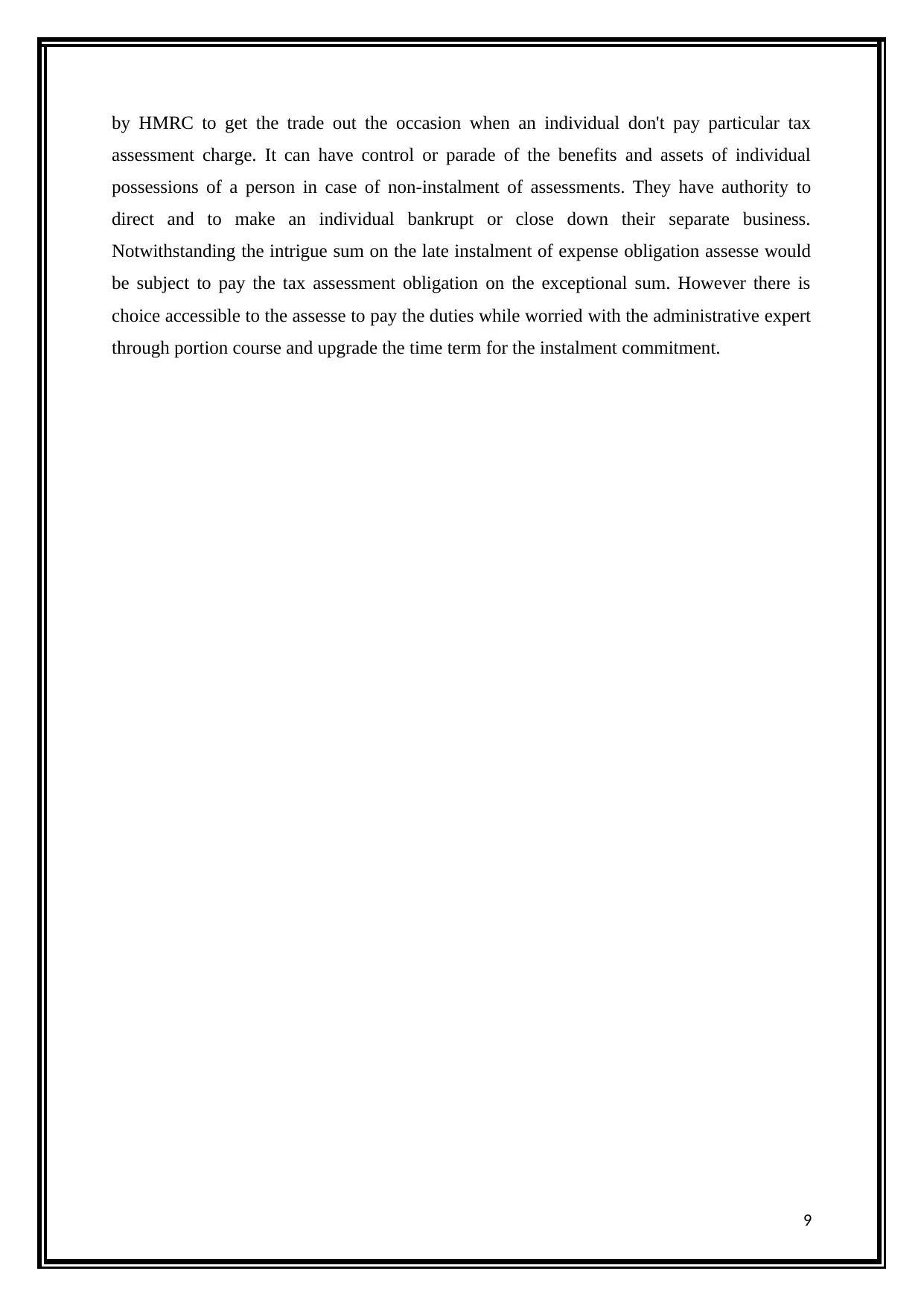
by HMRC to get the trade out the occasion when an individual don't pay particular tax
assessment charge. It can have control or parade of the benefits and assets of individual
possessions of a person in case of non-instalment of assessments. They have authority to
direct and to make an individual bankrupt or close down their separate business.
Notwithstanding the intrigue sum on the late instalment of expense obligation assesse would
be subject to pay the tax assessment obligation on the exceptional sum. However there is
choice accessible to the assesse to pay the duties while worried with the administrative expert
through portion course and upgrade the time term for the instalment commitment.
9
assessment charge. It can have control or parade of the benefits and assets of individual
possessions of a person in case of non-instalment of assessments. They have authority to
direct and to make an individual bankrupt or close down their separate business.
Notwithstanding the intrigue sum on the late instalment of expense obligation assesse would
be subject to pay the tax assessment obligation on the exceptional sum. However there is
choice accessible to the assesse to pay the duties while worried with the administrative expert
through portion course and upgrade the time term for the instalment commitment.
9
⊘ This is a preview!⊘
Do you want full access?
Subscribe today to unlock all pages.

Trusted by 1+ million students worldwide
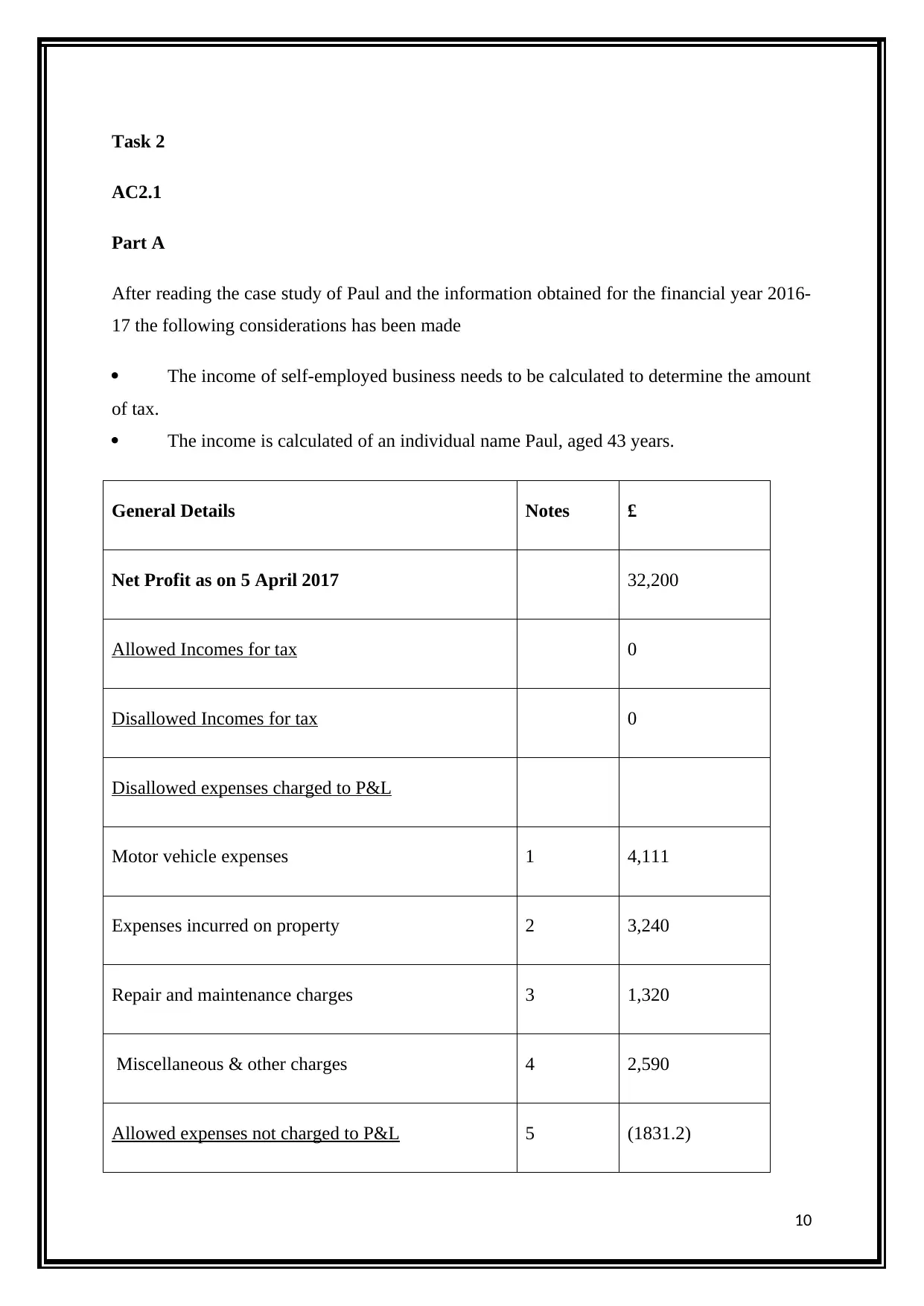
Task 2
AC2.1
Part A
After reading the case study of Paul and the information obtained for the financial year 2016-
17 the following considerations has been made
The income of self-employed business needs to be calculated to determine the amount
of tax.
The income is calculated of an individual name Paul, aged 43 years.
General Details Notes £
Net Profit as on 5 April 2017 32,200
Allowed Incomes for tax 0
Disallowed Incomes for tax 0
Disallowed expenses charged to P&L
Motor vehicle expenses 1 4,111
Expenses incurred on property 2 3,240
Repair and maintenance charges 3 1,320
Miscellaneous & other charges 4 2,590
Allowed expenses not charged to P&L 5 (1831.2)
10
AC2.1
Part A
After reading the case study of Paul and the information obtained for the financial year 2016-
17 the following considerations has been made
The income of self-employed business needs to be calculated to determine the amount
of tax.
The income is calculated of an individual name Paul, aged 43 years.
General Details Notes £
Net Profit as on 5 April 2017 32,200
Allowed Incomes for tax 0
Disallowed Incomes for tax 0
Disallowed expenses charged to P&L
Motor vehicle expenses 1 4,111
Expenses incurred on property 2 3,240
Repair and maintenance charges 3 1,320
Miscellaneous & other charges 4 2,590
Allowed expenses not charged to P&L 5 (1831.2)
10
Paraphrase This Document
Need a fresh take? Get an instant paraphrase of this document with our AI Paraphraser
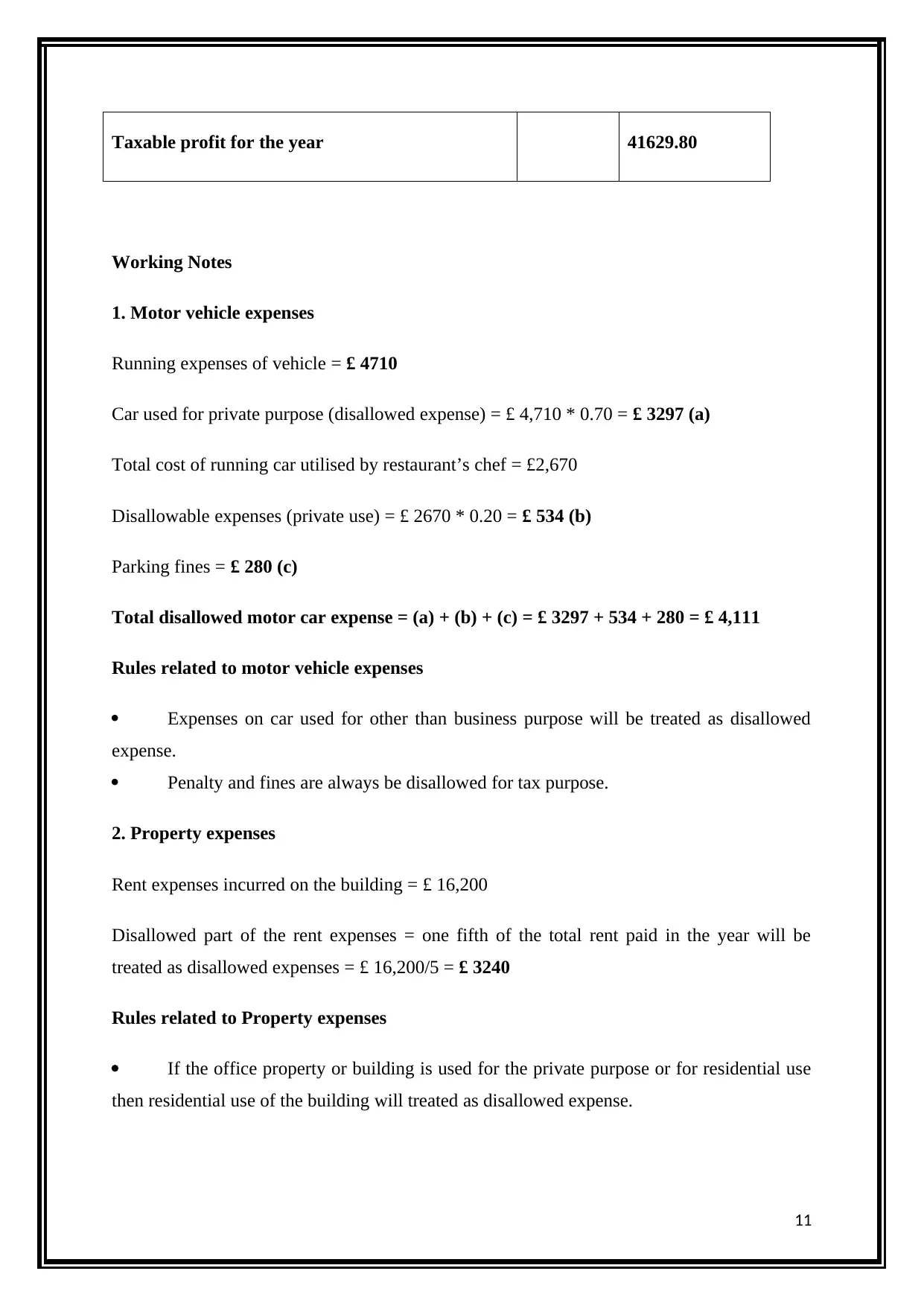
Taxable profit for the year 41629.80
Working Notes
1. Motor vehicle expenses
Running expenses of vehicle = £ 4710
Car used for private purpose (disallowed expense) = £ 4,710 * 0.70 = £ 3297 (a)
Total cost of running car utilised by restaurant’s chef = £2,670
Disallowable expenses (private use) = £ 2670 * 0.20 = £ 534 (b)
Parking fines = £ 280 (c)
Total disallowed motor car expense = (a) + (b) + (c) = £ 3297 + 534 + 280 = £ 4,111
Rules related to motor vehicle expenses
Expenses on car used for other than business purpose will be treated as disallowed
expense.
Penalty and fines are always be disallowed for tax purpose.
2. Property expenses
Rent expenses incurred on the building = £ 16,200
Disallowed part of the rent expenses = one fifth of the total rent paid in the year will be
treated as disallowed expenses = £ 16,200/5 = £ 3240
Rules related to Property expenses
If the office property or building is used for the private purpose or for residential use
then residential use of the building will treated as disallowed expense.
11
Working Notes
1. Motor vehicle expenses
Running expenses of vehicle = £ 4710
Car used for private purpose (disallowed expense) = £ 4,710 * 0.70 = £ 3297 (a)
Total cost of running car utilised by restaurant’s chef = £2,670
Disallowable expenses (private use) = £ 2670 * 0.20 = £ 534 (b)
Parking fines = £ 280 (c)
Total disallowed motor car expense = (a) + (b) + (c) = £ 3297 + 534 + 280 = £ 4,111
Rules related to motor vehicle expenses
Expenses on car used for other than business purpose will be treated as disallowed
expense.
Penalty and fines are always be disallowed for tax purpose.
2. Property expenses
Rent expenses incurred on the building = £ 16,200
Disallowed part of the rent expenses = one fifth of the total rent paid in the year will be
treated as disallowed expenses = £ 16,200/5 = £ 3240
Rules related to Property expenses
If the office property or building is used for the private purpose or for residential use
then residential use of the building will treated as disallowed expense.
11
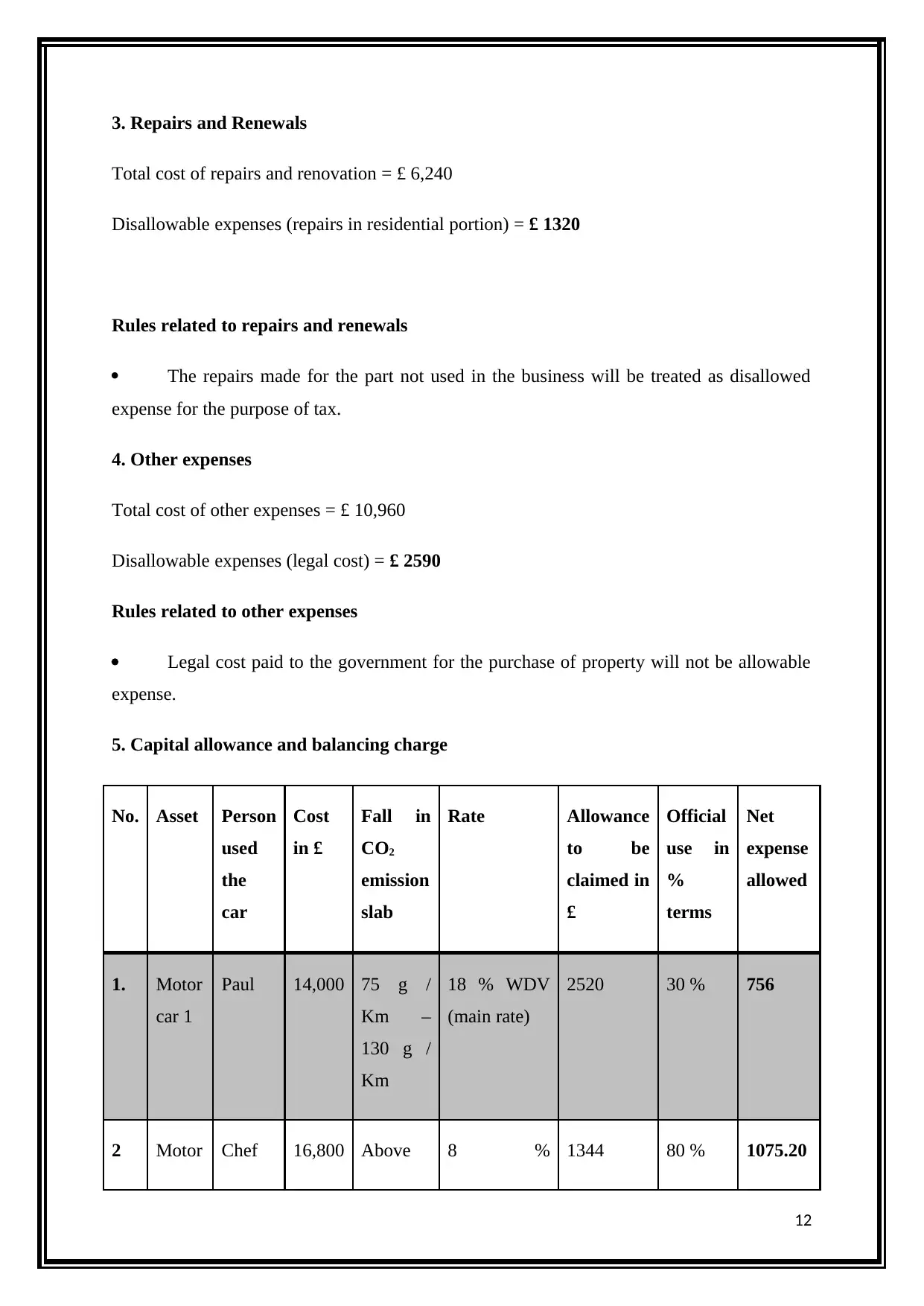
3. Repairs and Renewals
Total cost of repairs and renovation = £ 6,240
Disallowable expenses (repairs in residential portion) = £ 1320
Rules related to repairs and renewals
The repairs made for the part not used in the business will be treated as disallowed
expense for the purpose of tax.
4. Other expenses
Total cost of other expenses = £ 10,960
Disallowable expenses (legal cost) = £ 2590
Rules related to other expenses
Legal cost paid to the government for the purchase of property will not be allowable
expense.
5. Capital allowance and balancing charge
No. Asset Person
used
the
car
Cost
in £
Fall in
CO2
emission
slab
Rate Allowance
to be
claimed in
£
Official
use in
%
terms
Net
expense
allowed
1. Motor
car 1
Paul 14,000 75 g /
Km –
130 g /
Km
18 % WDV
(main rate)
2520 30 % 756
2 Motor Chef 16,800 Above 8 % 1344 80 % 1075.20
12
Total cost of repairs and renovation = £ 6,240
Disallowable expenses (repairs in residential portion) = £ 1320
Rules related to repairs and renewals
The repairs made for the part not used in the business will be treated as disallowed
expense for the purpose of tax.
4. Other expenses
Total cost of other expenses = £ 10,960
Disallowable expenses (legal cost) = £ 2590
Rules related to other expenses
Legal cost paid to the government for the purchase of property will not be allowable
expense.
5. Capital allowance and balancing charge
No. Asset Person
used
the
car
Cost
in £
Fall in
CO2
emission
slab
Rate Allowance
to be
claimed in
£
Official
use in
%
terms
Net
expense
allowed
1. Motor
car 1
Paul 14,000 75 g /
Km –
130 g /
Km
18 % WDV
(main rate)
2520 30 % 756
2 Motor Chef 16,800 Above 8 % 1344 80 % 1075.20
12
⊘ This is a preview!⊘
Do you want full access?
Subscribe today to unlock all pages.

Trusted by 1+ million students worldwide
1 out of 29
Related Documents
Your All-in-One AI-Powered Toolkit for Academic Success.
+13062052269
info@desklib.com
Available 24*7 on WhatsApp / Email
![[object Object]](/_next/static/media/star-bottom.7253800d.svg)
Unlock your academic potential
Copyright © 2020–2025 A2Z Services. All Rights Reserved. Developed and managed by ZUCOL.





